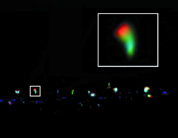

The brain's capacity to modify connections between neurons in response to
experience is termed plasticity. Plasticity is a prominent feature of brain
development and in the adult underlies learning and memory processes as well
as adaptive reorganization of primary sensory maps. In the case of both developmental
and adult plasticity, there is evidence that long-term synaptic changes involve
activation of gene expression. Elucidating the function of such genes can
provide insight into molecular and cellular mechanisms that generate plasticity
at the synapse.
We have developed a highly sensitive subtractive cloning and differential screening method that has allowed us to identify and isolate a large pool of genes involved in neuronal plasticity. These approximately 315 candidate plasticity genes (CPGs) constitute the basis of our studies.
Partial sequence analysis
in combination with database search programs show that 190 of the cloned CPGs
encode known proteins, while approximately 125 are novel. We have used in
situ hybridization to temporally and spatially localize expression of approximately
80 individual CPGs. We found many CPGs to be specific to the brain, among
them a group exclusive to the hippocampal dentate gyrus (a region of the brain
associated with learning and memory). Fifty CPGs were screened by two additional
criteria: cortical expression during activity dependent phases of development
and induction by a physiological sensory stimulus (light) specifically in
the visual cortex. In a group of 30 CPGs chosen because of their expression
patterns for full-length cloning and sequencing, we identified two new seven-transmembrane
domain receptors, a new serine/threonine kinase, a new MAP-kinase phosphatase,
a dystrophin-like cytoskeletal protein, and two potential trophic factors.
This sample of CPGs demonstrates that the CPG pool contains many interesting
proteins whose expression is regulated by activity. At present, there are
two novel CPGs, CPG15 and CPG2, under full-scale investigation in the lab.



Fred and Carol Middleton
Assistant Professor, Departments of Brain and Cognitive Sciences and Biology
Elly Nedivi received
her Ph.D. in Neuroscience from Stanford University Medical School and completed
her postdoctoral training at The Weitzmann Institute in Israel. In 1998, after
completing research at Cold Spring Harbor Laboratory, she joined the faculty
of the Department of Brain and Cognitive Sciences and the Picower Center for
Learning and Memory at MIT. Dr. Nedivi is the recipient of the Ellison Medical
Foundation New Scholar Award and an Alfred P. Sloan Foundation Fellowship.
laboratory webpage
 |